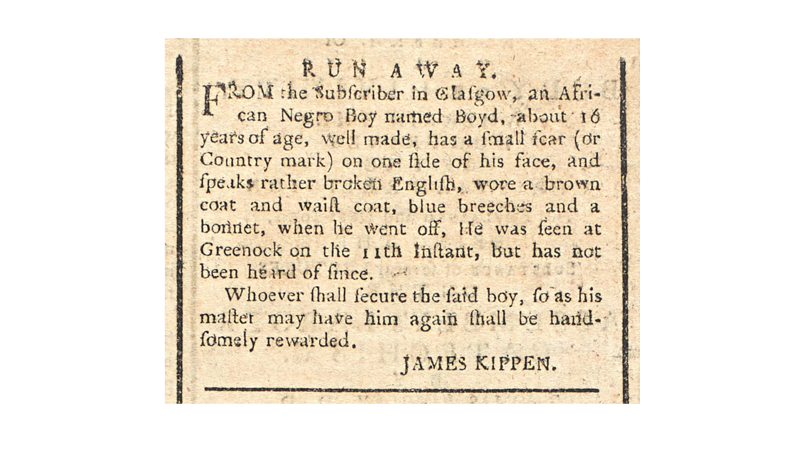Boyd, an Enslaved African in Glasgow

'Run Away'
Newspaper advert
Glasgow Journal, 19-26 July 1770, page 4
14th August 2018
In the summer of 1770, a sixteen-year-old enslaved boy named Boyd escaped from his master in Glasgow.
This advertisement was placed in the Glasgow Journal by James Kippen, who had been the master of a ship named Lady Margaret which had left Greenock for Virginia in January of 1770. It was not uncommon for ship captains and officers to own enslaved boys and men who worked for their owners on the ships, both as personal servants and as crewmen.
A famous example was Olaudah Equiano, who was the property of several naval officers before eventually securing his freedom and becoming a major supporter of the abolition of the transatlantic slave trade. Boyd was almost certainly aboard the Lady Margaret when the ship was damaged by a storm off the Irish coast, limping back to Scotland before being driven ashore and wrecked on the Ayrshire coast.
Perhaps Boyd did not fancy another dangerous voyage with Kippen, or maybe he worried that like other enslaved boys owned by ship’s officers he might be sold in America or the Caribbean and put to work in a far worse form of slavery. But it cannot have been easy for Boyd to hide his identity after escaping. The advertisement revealed that Boyd had been born in West Africa, and this was confirmed by his ‘rather broken English’ and by the ‘Country Mark’ on his face. Various societies in West Africa practised a form of ritual scarification, inscribing lines and designs on the faces, arms and torsos of children. These practices were not continued in the Caribbean or America, which meant that ‘Country Marks’ as they were known were a visible indication that the bearer was from Africa, and thus almost certainly had been and most likely still was enslaved.
As is the case with most runaway advertisements, we do not know what became of Boyd, and whether or not his bid for freedom was successful. It is possible that as an African, perhaps with seafaring experience, he was able to find work on another ship as a free man and sailor. Ships traversing the Atlantic had multi-racial crews, and as Equiano’s autobiography reveals this was a working environment in which a degree of racial equality was possible: in the midst of a storm sailors cared more about the abilities of crewmen than the colour of their skins. Moreover, ships trading in gold and even slaves on the West African coast often recruited West Africans who could help conduct negotiations, and even former slaves might themselves take part in the trade. Boyd may well have been recaptured, but perhaps he was able to find work and freedom as a sailor.
Professor Simon P. Newman
History, School of Humanities, University of Glasgow
